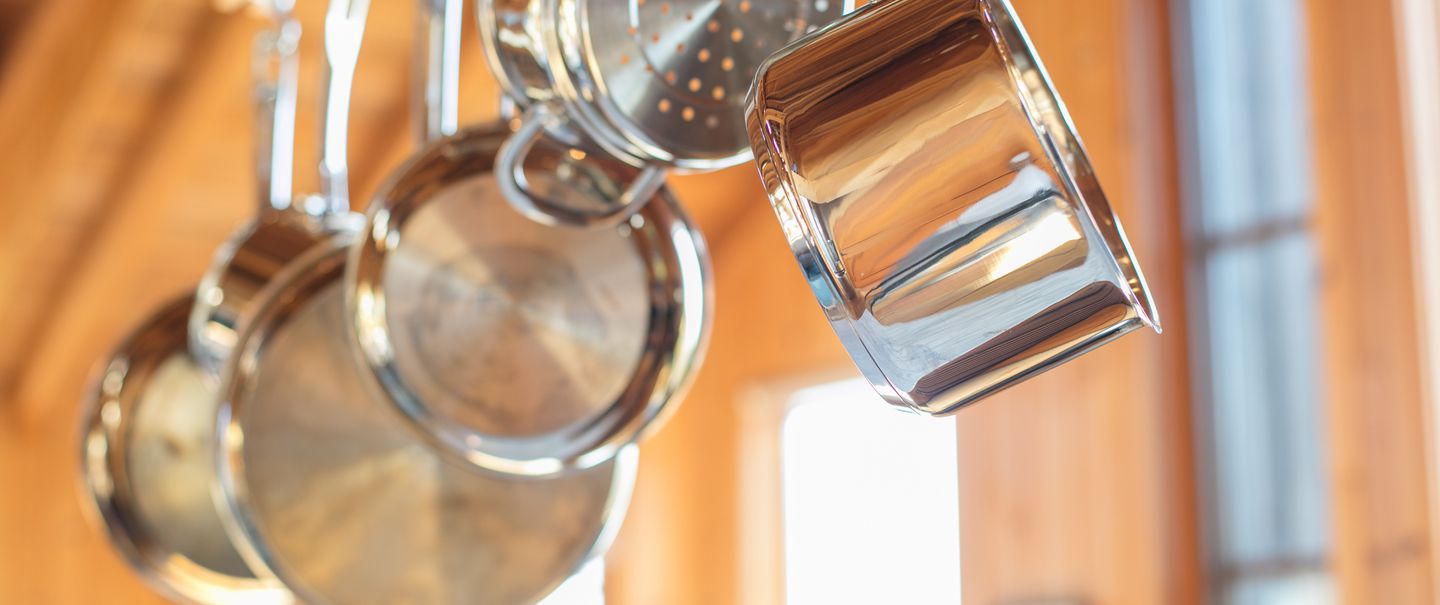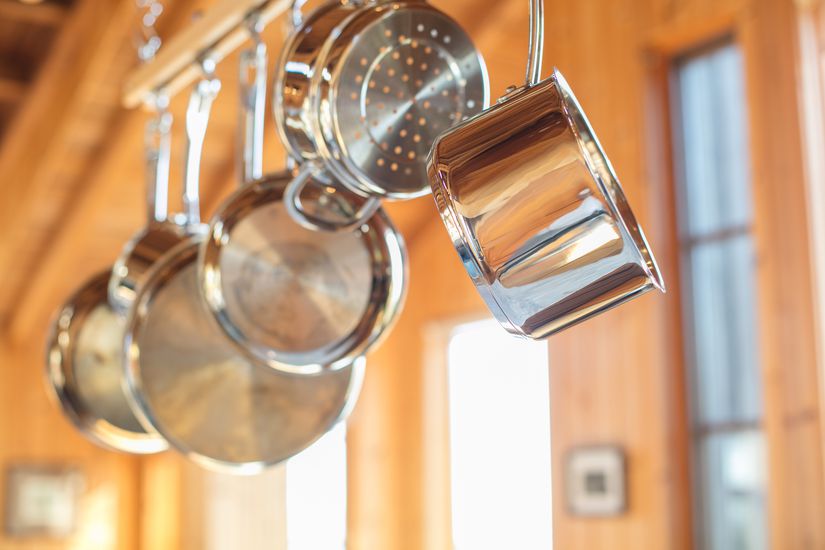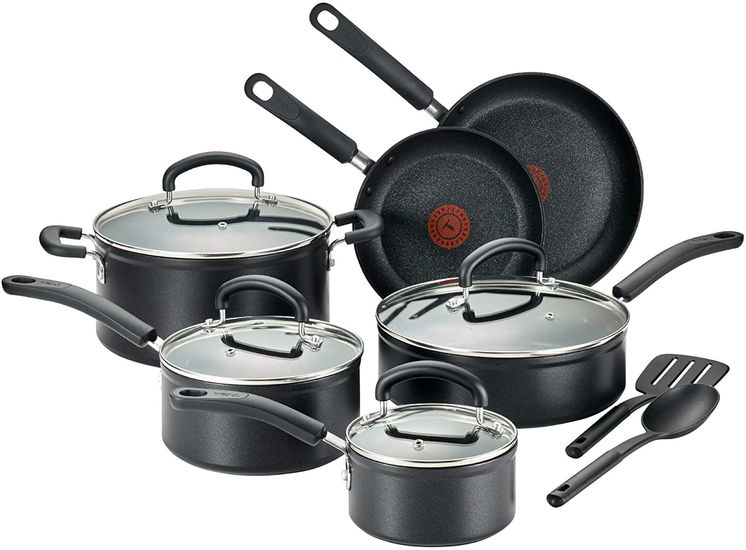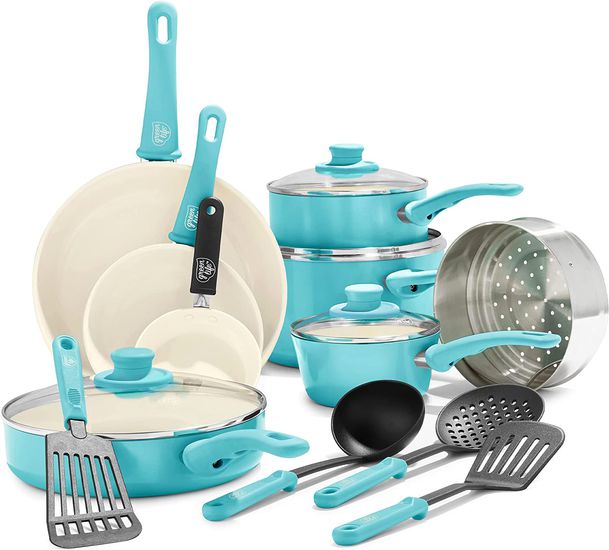Whether you’re setting up a new home, ready to refresh your kitchenware, or looking for a good gift, a quality cookware set is the ticket. Preferences and prices vary widely, however. Well-burnished names such as All-Clad, Le Creuset, Calphalon, and Swiss Diamond are aspirational, gourmet brands that can easily cost well over $700 for a set. But it's possible to get a good set of cheap pots and pans that features elements of the upmarket sets. We found several cookware sets, bearing brand names such as Farberware or T-fal, for around $100 that can help home cooks turn out good-tasting, good-looking food on the cheap.
Expert sources such as America's Test Kitchen tend to evaluate individual pots and pans with high price tags. Most of the cookware sets tested by Consumer Reports and the Good Housekeeping Research Institute also exceed our low price ceiling, and the handful of budget options in those tests generally did not perform well. In choosing the best cheap cookware sets, we relied heavily on reviews by home cooks on retail sites such as Amazon, Walmart, Macy's, and Bed Bath & Beyond.
Ultimately, frugal shoppers want good-quality cookware that does the job competently. Consumers want a well-rounded set with pieces they'll actually use. Oven-safe pieces are a particular boon. The quality should be good enough that the pots and pans don’t burn easily and the lids should fit properly. Reviewers who use nonstick cookware are adamant that the coating should be durable and not scratch or flake. The best cookware, whether nonstick or stainless steel, evenly distributes heat so food doesn't get burned. Cooking and cleaning should both be easy. Foodies may assert that only expensive cookware can produce gourmet meals, but the cookware reviews we read suggest that frugal cooks are more than satisfied with the dishes that come out of their cheap cookware.
But before making a purchase, cheap or otherwise, you should also consider what kind of cookware is right for your range. This is particularly important with a smooth, ceramic-glass or induction stovetop, because some cookware can't be used on those heating elements. And, while some swear by nonstick cookware for low-fat cooking and easy cleaning, others express concern about potential health risks and prefer stainless steel or ceramic. Take account of your cooking style, too: What size pots and pans do you prefer? Do you want to peer into a covered pot through a glass lid as a dish bubbles away? Do you prefer metal spoons and spatulas or plastic, wood, or silicone? Do you mind washing by hand? Also, pay attention to the handle: Will the vessel be comfortable to hold when full? Will the handle get hot to the touch? You might try stopping in a nearby store to physically check out the goods: feel the weight, hold the handle, and inspect the finish.
Pricey vs. Cheap Cookware
Surely a soupçon of snob appeal partly accounts for the sky-high prices affixed to gourmet cookware. But the difference in build quality — the material components and how they're put together — is the primary factor that distinguishes cheap cookware sets from the rest. The rap on super low-cost cookware is that food scorches, pots have hot spots, the bottoms warp, the finish stains, and the nonstick coating flakes off. Pricier cookware tends to be heavy duty, far more durable, and — holding the cook's skills constant — likely to deliver better results. These pans transmit heat evenly and quickly, so food cooks faster at lower temperatures; seared meats and caramelized vegetables are easily accomplished.
The component materials of choice in the mid- and upper ranges of the market include cast iron, aluminum, copper, and stainless steel. Some higher-cost cookware features a nonstick finish, but many pieces have stainless steel or hard anodized aluminum interiors crafted in a way that makes them easy to clean. Cast iron can be finished with an enamel coating. Consumers who buy high-end cookware undoubtedly figure they're making a long-term investment.
Most budget cookware is made from aluminum, carbon steel, or stainless steel. The interior cooking surface may be the same metal as the exterior, but cheap aluminum and carbon steel cookware usually features a chemically based nonstick finish; although less toxic, more eco-friendly options are becoming more widely available, even in the Cheapism price range.
Nonstick Cookware
A nonstick coating applied to a metal pot or pan helps it release foods easily and clean up quickly. With a nonstick surface, users can cook without adding any fat to the pan, or at least very little. This makes nonstick cookware the most popular choice among home cooks. But keep in mind that a nonstick surface doesn't brown or caramelize foods very well, and the coating can scratch off if you don't treat the pieces with care. We read reports from users saying the nonstick surface of some low-cost cookware degrades quickly, raising concerns about the release of potentially toxic compounds. Bottom line, according to experts: Avoid temperatures higher than 500 degrees, and if the nonstick coating starts chipping off, it's best to toss the cookware. While many people have expressed concern about chemicals from nonstick cookware leaching into food, most newer nonstick surfaces are PFOA-free.
Some nonstick cookware boasts a titanium coating that makes it nontoxic and safe to use with metal utensils. Titanium is a selling point because it's very durable; it’s nonporous, so smells won’t seep in; and it’s unaffected by acids. It also resists corrosion and scratching. Titanium is usually combined with ceramic to produce a coating that is both nonstick and that distributes heat evenly, as pure titanium does not conduct heat well. Premium titanium-reinforced cookware can be quite costly.
Stainless Steel Cookware
Although the Food and Drug Administration has found no risk to humans, the health concerns surrounding nonstick cookware prompt many consumers to seek out other materials. With that in mind, we looked at a relatively easy-to-use alternative available on a budget: stainless steel. Stainless steel cookware is the most versatile, because it can be used on any type of range, is oven safe, and can withstand a good bit of heat without worry of damaging the pan (although discoloration is often an issue).
Stainless steel is dense, does not hold smells or tastes, and is highly resistant to pitting or staining. It is also strong and nonreactive, which means that acidic foods such as tomatoes won't damage it. Unlike aluminum, the basis of many low-cost pots and pans, steel is magnetic (as is cast iron) and will work on an induction stovetop. However, steel is not as good at conducting heat, so the best cheap stainless steel cookware incorporates an aluminum or copper disk at the bottom for better heat diffusion. Some cookware sets also let users keep one foot in each world, by combining stainless steel pots and nonstick aluminum skillets in the same set.
Ceramic Cookware
Another alternative to traditional nonstick pots and pans is ceramic cookware, which releases foods just as easily but is nontoxic and distributes heat more evenly. It’s also nonporous and nonreactive, so there won’t be any residual smells, and users can cook acidic foods like tomatoes without the worry of leaching chemicals.
Despite its health benefits, ceramic cookware may just be too finicky to suit everyone’s taste. While one of the benefits of a nonstick surface is that added fats are not needed, the directions on most cheap ceramic cookware expressly caution users not to use olive oil or cooking spray, because these oils burn at a low temperature and can carbonize, adding burnt spots to the pans. Users are also admonished to use ceramic pans only on low to medium heat. High heat can cause foods to stick and damage the surface. Like regular nonstick cookware, ceramic has a coating that makes it sensitive to scratching, so users should avoid metal utensils. Note also, that “copper” ceramic is not to be confused with true copper cookware — most of these pans simply have a copper-colored coating and are made of little to no actual copper.
Some reviewers say that, although they follow the rules for care and usage assiduously, pans still become scratched and discolored. Some also lament the inability to get a good, dark sear on meats using this type of pan. And since the exterior of ceramic cookware is aluminum, it usually can’t be used on induction ranges, although manufacturers are now producing aluminum sets with specialized magnetic bases. (There’s also the option of purchasing an induction interface disk for your stovetop; with these stainless steel disks, you can use any type of pot or pan on an induction range.)
Cast Iron Cookware
While it’s hard to come by cast iron cookware on the cheap, it has a number of advantages. Cast iron is good for searing foods like steaks, because it can get screaming hot with no adverse effects, although it can take a while to heat up. It can go in the oven at any temperature and cleans very easily (a well-seasoned cast iron pan is, for all intents and purposes, nonstick). For the price, there is probably nothing more durable; cast iron is practically indestructible. Some people have cast iron cookware that was passed down from their grandparents and certainly will be around for future generations. There are no chemicals that could potentially leach into foods, although some iron may be absorbed if the pan is not well-seasoned (this could actually be a plus for people who are anemic).
On the downside, there’s no getting around the fact that cast iron is really heavy; lifting a full pot is a two-fisted job. Handles are not coated, so oven mitts are a necessity. Dropping a cast iron pan on a glass-top stove can be a disaster, and they can easily scratch surfaces (some recommend using parchment paper or a silicone baking mat when cooking atop an induction range). Because it’s porous, cast iron can hold smells such as fish or garlic, and tomato sauce cooked in a cast iron pot can come away with an off color and a metallic taste. Enameled cast iron has a coating, which does away with the problems of porousness and pre-seasoning, but it is among the most expensive types of cookware on the market and far above our price threshold. Finally, cast iron can’t go in the dishwasher — in fact, even using soap is not recommended, because it can wear away that hard-won seasoning.
Cookware Pieces
What comes in a set of cheap cookware? That all depends. Expect to get a combination of saucepans, skillets/fry pans (with slanted sides) or sauté pans (with straight sides), a stockpot or Dutch oven, and a few lids. Larger sets usually come with a bonus of some kind, such as a griddle. A full set can be a bargain, especially for a first home, but only for someone who's going to use all (or most) of the pieces in it. Consumers should match our picks against the way they cook and what they really need.
A cookware set may contain as few as three pieces or more than 30. Note that those numbers often include lids, cooking utensils, and other miscellaneous items in addition to pots and pans. Also, price is not an indicator of the quantity of pieces that make up a cookware set. One of the cheapest we researched boasts 83 pieces.
The size of the pieces seems to be a bigger issue for reviewers than the size of the set. A budget set might have a 3.25-quart Dutch oven, for example, compared with the 5-quart size that's typical among the best cheap cookware. Consumers are often surprised at the relatively small size of the pots and pans in many cheap cookware sets; a 1-quart saucepan doesn’t hold an awful lot, particularly when serving a family. If you routinely cook for a crowd, you'll probably need to augment a cookware set with larger open-stock pieces that may or may not match.
Oven Safety
Some cooking methods, such as braising, call for a dish started on the stovetop to be transferred to the oven. While cheap aluminum and stainless steel pans are typically oven-safe, the temperature they can withstand depends largely on the handle material. Consumers appreciate "stay-cool" handles made of silicone, plastic, or Bakelite (a type of resin), because they don't require potholders, but most max out at about 350 degrees. Some nonstick pans also can't go in the oven. Although all our top picks are oven-safe cookware, be sure to check the manufacturer's directions before attempting to put a nonstick pan in the oven. For example, a pan might be safe up to 500 degrees unless the lid is on.
Construction and Durability
Consumers who use nonstick cookware are adamant that the coating should be truly nonstick. It should also be durable and not scratch or come off easily. Handles should be riveted onto the pots and pans, or they are likely to come loose. Scorch-free bottoms and proper-fitting lids are also important. Reviewers are somewhat divided on glass lids. They're useful because you can see what's going on in the pot without lifting lids, but consumers with small children or clumsy hands may worry about breakage. We looked for shatter-resistant lids.
Ease of Use
In general, users want cookware that makes the cooking process uncomplicated and the cleaning process speedy. Nonstick, ceramic, and cast iron cookware can usually be washed with a regular sponge, a big part of its appeal. Stainless steel pans might be a bit harder to clean but shouldn't rust or stain. Most cheap cookware featured here is dishwasher-safe, but manufacturers and experts recommend washing by hand. Cast iron should be washed only by hand, with minimal soap, to preserve the seasoning.


















